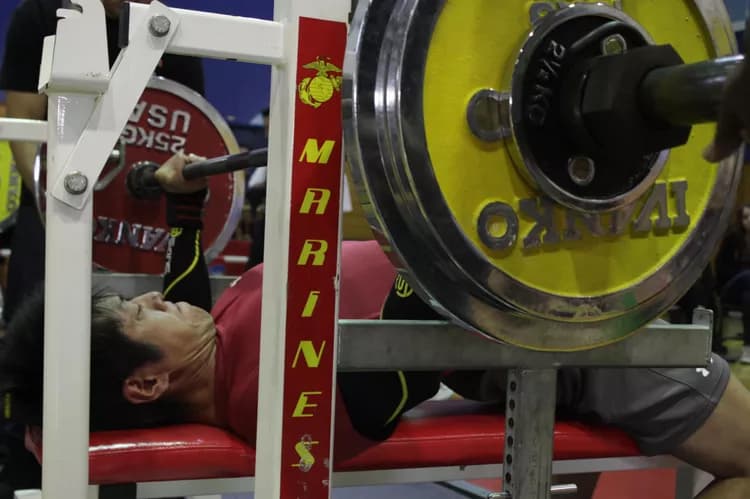The bench press is one of the first exercises most males try when beginning weight-training. This exercise targets many upper body muscle groups like the chest (pectoralis major), as well as supporting arms (triceps), shoulder muscles (anterior deltoids), serratus anterior, coracobrachialis, scapulae fixers, and trapezii. People use a barbell to hold the weight; however, a pair of dumbbells can also be used.
It has been observed that individuals rarely perform the bench press technique correctly. This has led to a multitude of injuries that includes a damaged rotator cuff, elbow or wrist strains, cracked ribs, torn shoulder ligaments or tendons, or death by suffocation by being trapped by the bar.
In order to prevent these risks, the bench exercise user must be aware of the proper technique and perform accordingly. The following include tips on how to perfect your bench workout:
- Lie flat down on the workout bench so that your eyes are looking directly at the bar. Keep your natural spinal curve. Pick a bench that fits your shoulder width comfortably. A bench that is too narrow is unstable, and a bench that is too broad prevents the upper arm from bending back.
- Firmly plant your feet on the ground. Your feet should not be moving around under any circumstances. Properly set feet are crucial for stability throughout the lift.
- Grip the barbell and lock your wrists in a neutral position. The knuckles of your four fingers should be behind the bar, not under it. The most conventional grip is where your hands are slightly outside shoulder width apart.
- Put an arc on your back to make your lower back come off the bench. Squeeze the bar tightly and unrack the weight. As you hold the weight, do not lock your elbows.
- Take a deep breath and slowly lower the weight to your chest with proper control. Do not let the weight drop and bounce off your chest. Keep your muscles tight. This includes your lat, back, abdominal, butt, and quad muslces. When lowered, your elbows should not be perpendicular to your body. Instead, your elbows should remain tight at a 45-degree angle.
- Use your entire body to press the weight back up. Exhale at the end of the rep. That is one rep.
Note:
Be sure to maintain eye focus at one point of the ceiling above where you are pressing. This technique can help you maintain stability throughout the lift. Remember to keep your muscles tight throughout the entire lift.
Additional Resources:
Feigenbaum, M. S., & Pollock, M. L. (1999). Prescription of resistance training for health and disease. Medicine and Science in Sports and Exercise, 31, 38-45.
Graham, J. F. (2000). Dumbbell Bench Press. Strength & Conditioning Journal,22(4), 71. Graham, J. F. (2000). Dumbbell Bench Press. Strength & Conditioning Journal,22(4), 71.
Koshida, S., Urabe, Y., Miyashita, K., Iwai, K., & Kagimori, A. (2008). Muscular outputs during dynamic bench press under stable versus unstable conditions.The Journal of Strength & Conditioning Research, 22(5), 1584-1588.
Helpful Peer-Reviewed Medical Articles:
Richmond, S. R., & Godard, M. P. (2004). The effects of varied rest periods between sets to failure using the bench press in recreationally trained men. The Journal of Strength & Conditioning Research, 18(4), 846-849.
BAKER, D., NANCE, S., & MOORE, M. (2001). The load that maximizes the average mechanical power output during explosive bench press throws in highly trained athletes. The Journal of Strength & Conditioning Research, 15(1), 20-24.
Santana, J. C., Vera-Garcia, F. J., & McGill, S. M. (2007). A kinetic and electromyographic comparison of the standing cable press and bench press. The Journal of Strength & Conditioning Research, 21(4), 1271-1277.
Robergs, R. A., Gordon, T., Reynolds, J., & Walker, T. B. (2007). Energy expenditure during bench press and squat exercises. The Journal of Strength & Conditioning Research, 21(1), 123-130.
Faigenbaum, A. D., Ratamess, N. A., McFarland, J., Kaczmarek, J., Coraggio, M., Kang, J., & Hoffman, J. (2008). Effect of rest interval length on bench press performance in boys, teens, and men. Pediatr Exerc Sci, 20(4), 457-469.
Related Articles
Test Your Knowledge
Asked by users
Related Centers
Related Specialties
Related Physicians
Related Procedures
Related Resources
Join DoveHubs
and connect with fellow professionals


0 Comments
Please log in to post a comment.